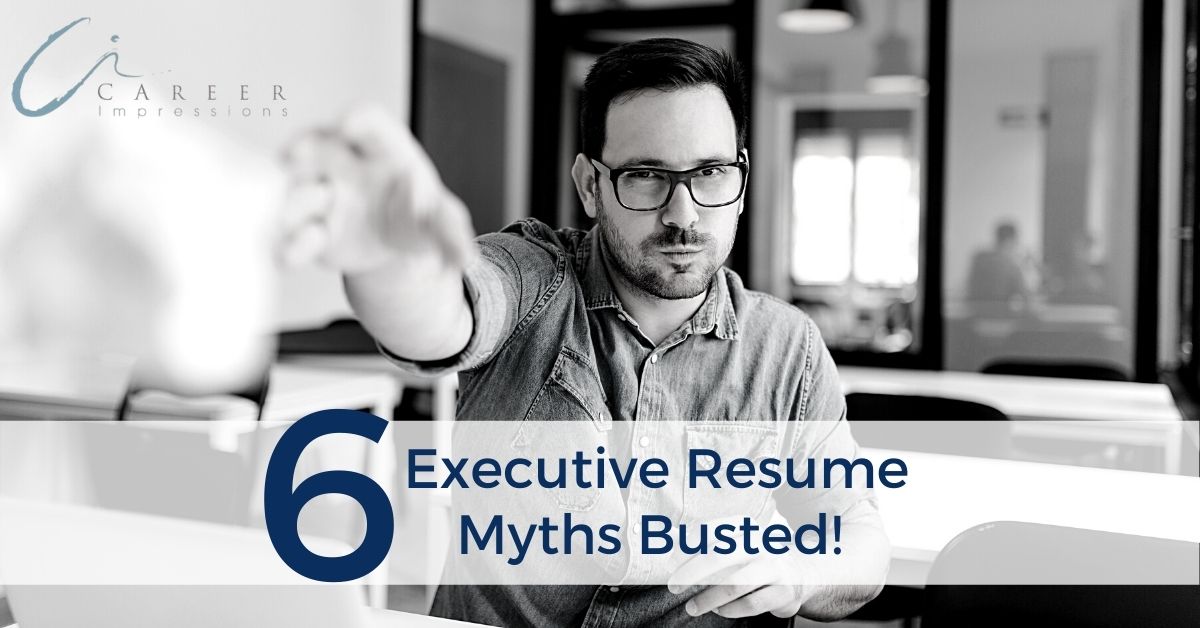
6 Executive Resume Myths Busted!

Today, I’m busting some of the top executive resume myths. There is an incredible amount of advice to be found on resumes, and it can be overwhelming to sort through the noise and choose the winning suggestions.
In my dozen-plus years as a professional resume writer, I have seen these same misconceptions come up again and again. I’m here to tell you that not all resume-writing suggestions are created equal.
Myth #1: Stick to one page
Sticking to one page is probably the most common executive resume myth, as experts continue to debate ideal length.
You’ll have a significant list of work experience and accomplishments at the executive level that won’t fit on one page. You are far better off creating a 2 to 3-page document that is visually appealing, properly formatted, and easy to read. Ultimately, the quality of the content matters more than the quantity.
Use resume space-saving tips such as switching the font, eliminating filler words, and shrinking margins to make the most of those precious pages. You could also create a resume addendum highlighting accomplishments, awards, and publications to include as you see fit.
Myth #2: Include every detail
More is not always better. Including too much detail in your executive resume can overwhelm readers and suffocate crucial information and keywords.
Your executive resume is a marketing document that must communicate your brand, focus, and value proposition. The company you are applying to has a problem, so you want to position yourself as the solution. Anything unrelated to their role and needs should be kept off your resume.
Think carefully about what information to include and how much weight you give to each piece of content. Your executive resume is precious real estate. Stick to the essential points that will resonate with the hiring committee.
Myth #3: Resumes aren’t necessary – it’s all about connections
While it’s true that many executives find opportunities through networking, a resume is still likely to be called upon at some stage of the hiring process.
Don’t miss out on a chance to make a fantastic impression with your file, ensuring your executive resume is developed according to modern trends, presenting you as a modern leader. You want to ensure your resume can stand tall next to any of your competitor’s files.
Myth #4: Include hobbies and personal information
There is no way to predict the personal bias of someone screening your resume. Please don’t give them a reason to rule you out by getting too personal. Analyze every line of your resume in the mindset of a potential employer, and ask, “Does this information directly relate to the value I can bring to the company?” If not, remove or replace.
Instead of sharing basic hobbies, save the space for board memberships, volunteer work, and personality traits relevant to your position, as they contribute to your personal brand.
Myth #5: One resume will work for all positions and companies
This executive resume myth may work if you only apply for a precise role within one industry, but most leaders could go in a few directions. Tweak your resume to the exact requirements of each position, portraying yourself as the perfect fit for that specific role. Resume customization is key.
Myth #6: Look doesn’t matter
It does. Although a fancy format is not required (because the content is what really matters in a resume), you still want the file to look professional and be easy to scan and absorb. If the file is hard to read (think: crammed, dense, tiny font, or weird layout with multiple columns), then it might not be read at all.
Additionally, a resume written in an old Microsoft Word template, in Times New Roman font, screams…old. Be mindful of how you present yourself in this critical career file. Aim for a modern format that includes appropriate white space and clearly marked sections. Consider the use of strategic design components like shading or bolding to help draw the reader’s eye to key points. And remember, when it comes to design – less can also be more.
Remember that there is no one way to craft an executive resume. Watch out for executive resume myths by carefully sifting through recommendations and choosing the best fit for you.
If you are looking for more resources to help create a stand-out resume, check out 7 Secrets of an Executive Resume That Gets Noticed.
